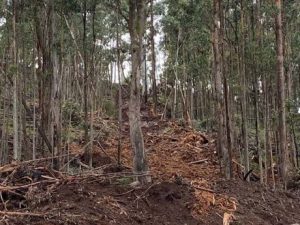
The storm-damaged Wombat Forest floor.
Supreme Court Justice Melinda Richards has issued an interim order halting the salvaging of some of the 600,000 tonnes of fallen trees left lying on the Wombat Forest floor after June 2021 storms. Source: The Weekly Times
In issuing the order on Tuesday, Justice Richards stated she did not accept the argument that the fallen trees needed to be removed to reduce the fire hazard “because I came to the view that the evidence did not support the claim”.
The interim order, halting firewood harvesting from the coupe, remains in place until 5pm, October 31, with the full case to be heard in the meantime.
Environmentalists’ have argued the more than 600,000 tonnes of rapidly drying windblown trees left lying on the Wombat Forest floor “are not considered a major cause of fire risk”.
The Wombat Forestcare group launched its Supreme Court action last week to halt firewood harvester Dale Tiley from salvaging fallen trees on a coupe they argued had not been adequately surveyed by VicForests, putting threatened species at risk.
In arguing the case, Wombat Forestcare’s barrister Jonathan Korman said the Victorian Government’s overall fuel hazard assessment guide stated it was fine fuels, not logs lying on the forest floor, which “contribute the most to the fire’s rate of spread and flame height”.
“It’s the fine fuel which is the issue here, not the logs on the ground,” Mr Korman said. “There’s simply no evidence at all to suggest that one of the elements Your Honour should take into account in assessing the balance of convenience is fire hazard,” Mr Korman said.
However when asked about the case, the nation’s top bushfire scientist, University of Melbourne Associate Professor Kevin Tolhurst, said the fallen timber risked fuelling a firestorm that could engulf nearby towns.
He said while fine fuels triggered the initial spread, there was plenty of research to show that “once the fire developed, the woody material, which is ten times the quantity of fine fuels, dramatically increased the heat output”.
“It’s what we saw in 2019-20 on the east coast of Australia, when fires became pyroconvective,” Prof Tolhurst said. Those fires pushed smoke and embers up to 12km into the air, creating their own weather.
“The fire then moves more quickly, because of extensive spotting, which in 2009 was five to seven kilometres (from the fire).”
“The other point to all this is when the woody material burns it has a much bigger impact on soils, plants and invertebrates – because the heat released is ten times more than fine fuels.”
During last Thursday’s hearing, VicForests’ barrister Fiona Hudgson argued one of the aims of removing the wind-thrown timber from the 2021 storms was to mitigate fire risk to local communities.
At the time Justice Richards said: “The question that’s been raised is how that objective is met by removing wind-thrown timber.
“I mean the timber was already there. It’s just it was standing up and now it’s lying on the ground.”
Ms Hudgson said: “Well, the Department of Environment and the Traditional Owners have deemed this to be a way to deal with fire management.”
Justice Richards said: “There’s just no evidence of that. How is it – how? The timber was already there.”
Prof Tolhurst said everyone had to understand there was a big difference between green standing trees and those that had dried out on the forest floor.






